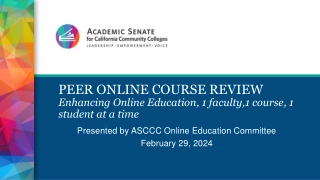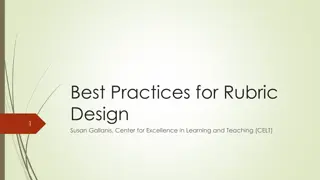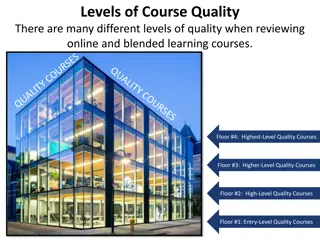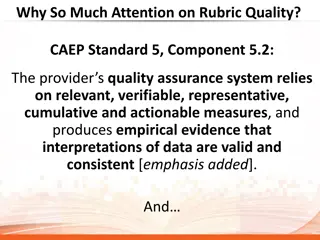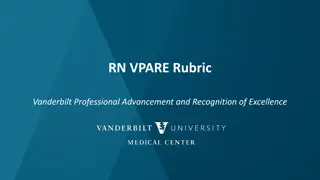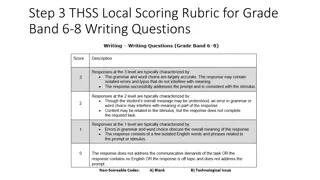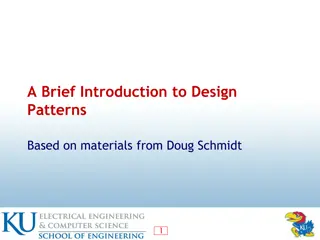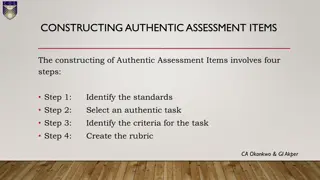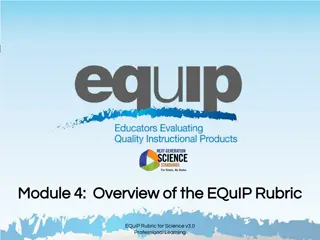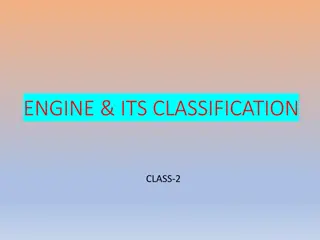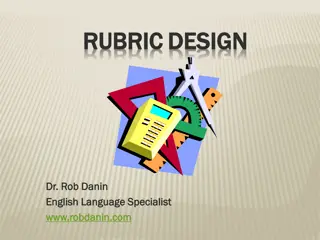Writing for PASS Blowing the Top off the Test
How to excel in the PASS writing assessment with this comprehensive guide. Includes test blueprint, scoring rubric, and sample answer document.
1 views • 51 slides
Enhancing Online Education: ASCCC Online Course Review
Explore the ASCCC Online Course Review on Enhancing Online Education presented by the ASCCC Online Education Committee. Learn about the CVC-OEI Course Design Rubric and its impact on local peer online course review initiatives. Discover how the California Virtual Campus Online Education Initiative a
0 views • 24 slides
Understanding Software Analysis and Design Process
Software analysis and design involve a systematic approach to understanding user requirements, creating logical models, and transitioning to detailed design specifications. Requirements analysis focuses on capturing system requirements, while design translates these requirements into implementation
7 views • 16 slides
Guide to Qualifying Exam at UConn BME Program
This guide outlines the importance of the Qualifying Exam as a rite of passage and a critical assessment of skills in written/oral communication, research project design, critical thinking, and more. It details the exam format, rubric, timeline, and key dates, providing insights into the NIH-style W
1 views • 9 slides
Guidelines for Design of Cement Concrete Pavement and Interlocking Paver Blocks
This document provides guidelines for designing cement concrete pavements and interlocking paver blocks, covering factors governing design, wheel loads, design period, subgrade characteristics, approximate k values based on CBR values, and the importance of a sub-base below concrete pavements. It em
0 views • 67 slides
Software Engineering Design Principles and Concepts
The chapter discusses the essential principles and concepts in software design, highlighting the four key design models - data design, architectural design, interface design, and component-level design. It emphasizes the importance of traceability to the analysis model, minimizing the gap between so
0 views • 36 slides
Best Practices for Rubric Design in Teaching
Explore the key components of rubrics, understand their importance in assessment, and learn how to effectively design and use them to enhance student learning outcomes.
0 views • 18 slides
Understanding Levels of Course Quality in Online Learning
Explore the different levels of course quality in online and blended learning, ranging from entry-level to highest-level courses. Quality Matters (QM) provides a well-respected rubric of course design standards to help institutions evaluate and improve course quality. Learn about the standards used
0 views • 17 slides
TDES Redesign Quarter 1 School Training Overview
In this training session facilitated for TDES School Team Members, participants will delve into the changes in the TDES system and rubric, understand HQSD evidence, PGP/PIP processes, and FAO procedures. The session also covers the changes to Article 13 of the CBA. Materials needed include the TDES
0 views • 47 slides
Candidate Assessment of Performance Using the CAP Rubric: Workshop Overview
This workshop conducted for program supervisors and supervising practitioners focuses on utilizing the CAP Rubric to assess candidate performance. The agenda includes warming up, learning about the CAP Rubric, understanding its goals and purposes, and detailing the CAP process. Participants engage i
0 views • 39 slides
Evaluation Criteria and Scoring Rubric for Arts and Culture Funding Applications
This document outlines the evaluation criteria and scoring rubric for funding applications in the arts and culture sector. It covers the quality of offerings, impact, track record, and other key aspects that will be assessed during the review process. Applicants must demonstrate the quality of their
0 views • 21 slides
Understanding System on Chip (SoC) Design and Components
Explore the world of System on Chip (SoC) design, components, and working flow. Learn about Intellectual Properties (IP), platform-based design, typical design flows, top-down design approach, and the emerging Electronic System Level (ESL) design flow. Discover the essential components of an SoC, su
0 views • 45 slides
Exploring Design Inspiration and Elements in Costume and Fashion Design
Dive into the world of costume and fashion design through a visual journey of finding design inspiration, understanding the design process, emphasizing originality, and exploring different sources of creativity. Discover how technology, art, food, history, architecture, and nature can spark innovati
0 views • 45 slides
Music Classroom Participation Rubric and Procedures
This content provides a detailed music classroom participation rubric covering aspects like student behavior, time management, active involvement, and facilitating learning. Additionally, it outlines music room procedures including entering quietly, taking attendance, bathroom and water protocols, b
0 views • 5 slides
Enhancing Piping Design Efficiency with Spec-Driven Technology
Explore how Spec-Driven Piping technology powered by CADACTIVE offers a standardized approach for piping design in Creo Parametric. This innovative extension streamlines design communication, eliminates errors, and improves design efficiency by utilizing a master catalog, automated checking capabili
0 views • 15 slides
Material Design: Combining Classic Design Principles with Technological Innovation
Material Design is a design language that combines traditional design principles with the possibilities offered by technology and science. It emphasizes visual language, classic design elements, and innovation to create delightful user experiences. The Material Metaphor, Imagery, Typography, Color,
0 views • 34 slides
Comprehensive Guide to System Design Components and Techniques
System design involves the detailed planning and identification of components in an information system, aiming to provide users with a general understanding of the new system. This process includes techniques like flowcharts, prototyping, and component design, covering aspects such as output design,
0 views • 24 slides
Understanding Design Patterns: A Comprehensive Overview
Exploring the world of design patterns, this content delves into the essence of design patterns, their application in software design to resolve complexity, and the different types of design patterns - creational, structural, and behavioral. It also showcases examples of popular design patterns such
0 views • 22 slides
Enhancing Rubric Quality in Educational Assessment
The focus on rubric quality in education, particularly in meeting CAEP Standard 5, Component 5.2 for quality assurance systems, is crucial for generating valid, reliable, and actionable data. CAEP now allows early submission of assessment instruments to improve data quality. However, common weakness
0 views • 22 slides
Understanding Basic Concepts in Software Design
Software design involves transforming customer requirements into a form suitable for implementation, with activities categorized into preliminary and detailed design stages. High-level design focuses on module identification and control relationships, while detailed design entails defining data stru
1 views • 24 slides
Vanderbilt Nursing Professional Advancement Rubric
Vanderbilt Nursing Professional Advancement Rubric outlines criteria and expectations for nurses to excel in various leadership, empowerment, knowledge, and practice areas. The rubric covers aspects like transformational leadership, structural empowerment, new knowledge acquisition, and exemplary pr
0 views • 55 slides
Exploring 3D Design and Critical Analysis in Architecture
Dive into the world of 3D design and critical analysis with a focus on architecture. Discover the stages of design, essential skills for designers, and areas of study in three-dimensional design. Delve into iconic buildings like Frank Lloyd Wright's Falling Water, analyze their key features, and eve
0 views • 9 slides
THSS Local Scoring Rubric for 6-8 Grade Band Writing Questions
The THSS Local Scoring Rubric provides guidelines for grading writing questions in grades 6-8. Students are required to craft questions for a visiting journalist, ensuring they are complete sentences. The example responses showcase a range of student engagement and language proficiency levels.
0 views • 10 slides
Understanding Design Patterns in Object-Oriented Design
Design patterns in object-oriented design (OOD) are essential templates that codify best practices for solving common problems. They help streamline development by capturing proven design decisions, promoting code reuse, and enhancing system flexibility and modularity. Learn about the core concepts,
0 views • 20 slides
Updates to Quality Matters 7th Edition Higher Education Rubric
Quality Matters (QM) has made significant updates to its 7th Edition Higher Education Rubric, including changes to point values, specific review standards, course resources, and overall wording. The new rubric emphasizes creating welcoming and inclusive courses, with key changes in terminology and a
0 views • 20 slides
Constructing Authentic Assessment Items: A Guide in 4 Steps
Constructing authentic assessment items involves four steps: identifying standards, selecting an authentic task, defining criteria, and creating a rubric. Standards are specific skills and knowledge students should gain. Tasks should reflect these standards. Criteria measure student mastery. Rubrics
0 views • 25 slides
Vanderbilt Nursing Professional Development Rubric
The Vanderbilt Nursing Professional Development Rubric outlines key areas of excellence and recognition criteria for nurses to advance in their careers. It covers transformational leadership, structural empowerment, new knowledge acquisition, and exemplary professional practice. The rubric encompass
0 views • 56 slides
Understanding Interaction Design in Human-Computer Interaction
Interaction design focuses on creating interactive products that are easy, effective, and enjoyable to use. It aims to reduce negative user experiences while enhancing positive ones. Designing interactive products requires understanding user activities, interfaces, and device arrangements to support
0 views • 11 slides
SE2811 Software Component Design Overview
This course covers software component design, design patterns, object-oriented design, algorithms, and opportunities for reuse in systems design. It emphasizes the importance of domain-level design and provides insights into solving core problems through reusable classes.
0 views • 21 slides
Guiding Principles for GETSI/INTEGRATE Webinar – Materials Development and Goals
The webinar presented by David Steer from the University of Akron focuses on guiding principles for material development in the context of GETSI/INTEGRATE modules. It outlines goals for the session, including discussing components of the guiding principles, examples of meeting those principles, and
0 views • 13 slides
Analysis of Bunch Lengthening in CEPC for Different Design Parameters
This study explores bunch lengthening in the Circular Electron Positron Collider (CEPC) for various design parameters, analyzing a 54 km design scheme, a 61 km design scheme, and a 100 km design scheme. The analysis includes the theoretical framework used, equations for bunch lengthening, and conclu
1 views • 15 slides
Understanding Plain & Reinforced Concrete Structures in Design Engineering
In the design of Plain & Reinforced Concrete structures, various strength design methods such as Ultimate Strength Design (USD) and Allowable Strength Design (ASD) are utilized. These methods involve factors of safety, material strength, load factors, and analysis in the elastic range. Additionally,
0 views • 11 slides
Understanding the EQuIP Rubric for Science: A Comprehensive Overview
Delve into the EQuIP Rubric for Science v3.0, exploring its development, structure, history, and key points. Learn about its purposes and objectives, including reviewing lessons, providing feedback, identifying exemplars, and informing new lesson development. Discover the three-category structure of
0 views • 12 slides
Verilog Adder Examples & Typical IC Design Flow
This comprehensive content delves into Verilog adder examples, typical IC design flow, physical design considerations, and examples of OpenGL ES GPU and ARM hypervisor applications. It covers the fundamentals of digital logic with Verilog design, hardware description language, FPGA prototyping, phys
0 views • 27 slides
Implementation of Arts and Entrepreneurship Assessment in Lesotho Primary Schools
The Ministry of Education and Training in Lesotho has introduced Arts and Entrepreneurship as a new subject in the primary school curriculum to cater to learners' diverse abilities. This paper explores the implementation of project-based assessment for Arts and Entrepreneurship, focusing on creativi
0 views • 14 slides
Understanding the Importance of Software Design for Data Scientists
Today's ISEA Session 2 with David Beck from the University of Washington delves into the critical role of intentional software design for data scientists. The session covers the software design approach, user-centric design stories, use cases, components, testing strategies, and the benefits and dra
0 views • 76 slides
Understanding Engine Classification and Design
Engine classification involves categorizing engines based on various factors such as combustion type, number of strokes, cylinder design, and ignition method. Common classifications include external and internal combustion engines, as well as categories based on the design and use of the engine. Add
0 views • 11 slides
Mastering Rubric Design for Effective Assessment
Rubrics are essential tools in evaluating and providing feedback on student performance. This comprehensive guide covers the definition, elements, and benefits of rubrics, along with expert tips on designing impactful rubrics for various assessments. Explore the art of rubric design, learn what make
0 views • 30 slides
Microsoft PowerPoint Best Practices for Authoring and Accessibility Workshop
Learn about the best practices for slide layout, text styling, and accessibility in Microsoft PowerPoint. Discover how to use pre-designed styles, slide layouts, and themes effectively. Understand the importance of slide titles, color usage, links, and standard layout components for accessibility co
0 views • 9 slides
Exam Rubric and Guidelines for European Theatre Module
The content discusses important information regarding the exam rubric for the European Theatre module, including guidelines on time limits, permitted topics, penalties for violations, and advice on handling exam questions. It clarifies rules on writing about the same texts as in coursework essays, s
0 views • 29 slides

